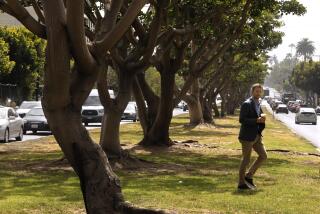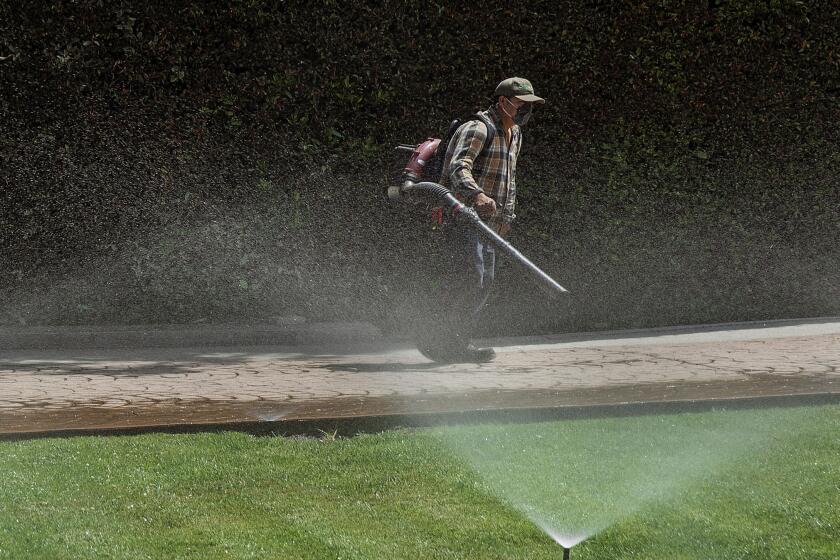Dyeing Lawns : Santa Barbara Residents Take Unusual Steps to Keep Grass Green in the Drought-Stricken City
- Share via
SANTA BARBARA — Dawn Clark’s cat gingerly walked across the newly painted lawn, stopped suddenly and looked bewildered. The cat sniffed tentatively, then bolted off the grass and spent the next few minutes trying to lick flecks of paint off its paws.
The lawn was recently mowed and as green as a billiard table. But while it looked like a typical lawn, it didn’t feel like one.
“Scratchy,” Clark said, after taking off her shoes and walking across the grass. “It doesn’t feel quite right.”
Santa Barbara residents have devised a number of innovative ways to keep their yards green since the city, faced with a nearly 50% water shortage for the year, declared a “drought emergency” in late February and became the first city in Southern California to ban lawn watering.
Clark’s cat had just experienced one: Several landscape companies now offer lawn painting services and local nurseries are stocking their shelves with green paint and pump sprayers.
“At least once a day someone comes in and buys green paint,” said Martin Senn, a manager at La Sumida Nursery. “After working hard all day, some people don’t want to come home to a brown lawn.”
Other residents are spreading a variety of green substances over their brown lawns, using shower water for irrigation or paying one of the numerous water companies now in business in Santa Barbara to pull up to their houses in tanker trucks and spray their yards with fire hoses.
These companies buy water from private wells, and don’t use city water, so the three “drought officers” from the Public Works Department can’t stop them from watering lawns. More than a dozen water companies have sprung up in Santa Barbara since the lawn-watering ban began.
Because of the high price for the service--up to $100 or more for each watering--the drought has created a class structure and divided the community between those who can afford to buy water or dig wells on their estates, and those whose lawns will die.
Companies that sell building material also have been doing a booming business. It appears that many Santa Barbarans would rather cover their yards with a variety of inorganic substances--including green concrete--than have a blemished lawn.
Some residents have removed their lawns, and others have just covered them with green gravel, stone or bark in the hopes that when the drought is over they can revive the lawns, said Bob McNall, owner of McNall Building Material.
During the last few months a number of new businesses have opened that install gray water systems--water piped from sinks, showers and washing machines--to landscaping. And as water bills rise dramatically, plumbers say, those who once found used water offensive, suddenly have overcome their aversion.
In affluent communities such as Hope Ranch and Montecito--also hit hard by the drought--an increasing number of residents are digging wells in their back yards so they will be assured a constant source of water for landscaping. Santa Barbara prohibits residents from drilling wells, but because it is legal in many nearby cities drilling companies from throughout the county have been flooded with calls.
“People are getting pretty paranoid . . . they’re afraid that one of these days they won’t be able to get any water at all,” said Jim Beane, manager of Southern Deep Well Drilling. “At least with a well, you don’t have to rely on outside sources.”
But some residents with wells have flaunted their abundance of water and angered neighbors, who have been watching their lawns die. In Hope Ranch, Saudi Arabian financier Essam Khashoggi created a stir by building on his large estate a 1 1/4-acre pond--with a dock for rowboats--that he intends to fill with well water. But the pond was built last year without all the required permits, and county zoning officials will decide later in the month whether he can fill it with water.
In Montecito, almost 100 people have received county permits to drill wells in the last few months, including billionaire corporate raider Harold Simmons, who ignored the worsening water shortage last year and drowned his 23-acre estate in a continuous cascade of water. He was fined $25,000 in 1989 by the Montecito Water District, which estimated he used enough water to supply an average family of four for 28 years. And Simmons is based in Dallas and only spends about 10 days a month at his Montecito estate.
The water district last year finally was forced to sharply restrict the flow of water to his home. But since Simmons recently drilled a well on his property and started receiving regular shipments of water from a tanker company, he has been able to keep his estate lush and green--legally.
Dawn Clark decided to hire a landscaper to paint her front lawn after she saw the grass slowly deteriorate from green, to yellow, to a pale sienna. Her husband, Duke, she said, is very meticulous and “likes a lawn to look like a lawn.”
Walter Barrows, a landscaper who painted the lawn, said he has received more than 30 calls a week since he began advertising his grass-painting service. He charges $45 to paint the average-size lawn with an “environmentally safe” vegetable dye, which will stay green, he said, for about six weeks.
“This kind of thing is done all over the country with football fields, lawn tennis courts and golf greens,” Barrows said. “But this is only a very temporary solution . . . we’ve got to have water within the next year or all the landscaping and rare trees in this city are going to be in trouble.”
While all of Southern California is suffering from a water shortage, the drought in the Santa Barbara area may be the most severe. Unlike Los Angeles and other areas in the state that have access to water from Northern California and the Colorado River, Santa Barbara relies almost entirely on ground-water supplies and rainwater. And Santa Barbara is entering its seventh year without adequate rainfall.
City officials are considering a number of unusual proposals for emergency supplies, including bringing in water by rail car from Colorado, importing Canadian water by barge, building a large seawater desalination plant and using an oil pipeline to transport water from Northern California.
The city hopes to have several alternative sources of water by the fall of 1991, said Pete Ramsdell, drought awareness manager for Santa Barbara.
And since the city increased water rates, banned lawn watering and prohibited residents from using hoses on trees and shrubs--only drip irrigation systems and watering by hand-held buckets are allowed--water use has decreased by about 40%, Ramsdell said.
Some residents have chosen simply to pay premium prices for water rather than conserve. Companies obtain their water supplies from private wells on ranches throughout the county and then charge homeowners between $100 and $200--depending on the size of the house--for a good soaking. Some residents and local motels pay for the service every other week.
“For our business, it’s worth the money to keep our lawns green and our landscaping looking good,” said Debbie Neer, manager of the Franciscan Inn. “People come to Santa Barbara because it’s so beautiful. . . . We can’t afford to lose that reputation.”
John Price had a water truck that supplied the carwashes he owns, but people who wanted their lawns irrigated stopped him so many times during the last two months that he decided to go into the water business. He opened a company called Channel Water Service and now has five trucks and 350 regular customers.
In addition to his tanker trucks, Price has 10 water trailers that he temporarily connects directly to customers’ sprinkler systems. He also paints lawns, fills swimming pools and rents water storage tanks--with pumps and hoses--that he refills regularly so customers can do the watering themselves.
“This wasn’t something I planned to get into,” said Price, as he watched one of his employees hose down a front lawn. “But I figured if people wanted my water so bad that they’d stop me on the street, it had to be a decent business.”
More to Read
Sign up for Essential California
The most important California stories and recommendations in your inbox every morning.
You may occasionally receive promotional content from the Los Angeles Times.













